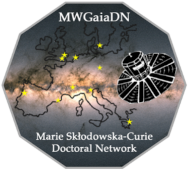This presentation will discuss the MWGaiaDN (see https://www.mwgaiadn.eu/) and current status.
This presentation will highlight the research projects being undertaken within MWGaiaDN, focusing on those most relevant in setting requirements on a future nearIR astrometry mission.
This presentation will discuss the communication activities of MWGaiaDN, and in particular note preparations for the final conference, which will set the scene for GaiaNIR.
This will cover the status of the GaiaNIR mission, a candidate for the ESA Voyage 2050 L5 launch slot.
[JASMINE][1] is a unique candidate for the competitive M-class Satellite Mission No. 3 at the Institute of Space and Astronautical Science (ISAS) of JAXA, whose launch is targeted for 2032. The mission has two science goals: (1) to explore the formation and evolution of the Milky Way Galaxy, and (2) to search for Earth-like exoplanets within the habitable zone. To achieve these goals, we will...
I will discuss lessons learned from Gaia as an astrophysics survey mission, emphasizing the need to complement the high accuracy astrometry with a rich set of astrophysical information. Illustrations from high impact science with Gaia will be used to make the point.
Discussion and round table from industry attendees. Challenges and perspectives for future large astrometry missions.
This presentation aims to provide technological and practical lessons we learned from Gaia. We will discuss insights from the data processing, and (systematic) effects of the instrument itself, as well as lessons we learned from processing the necessary auxiliary data like time-transformations (LATT, HATT) and orbital processing and analysis. Furthermore, we will discuss some aspects of what...
Edmund was the Gaia payload operations engineer at ESOC from before launch and throughout the flying mission, he has over 30 years of experience working with ESA satellites. In this presentation Edmund will introduce the operations concept for the payload and the successes and difficulties that were encountered. At the end of the Gaia operations, there were several weeks of technological...
DZA, the Deutsches Zentrum für Astrophysik, is an emerging national research center for astrophysics that is current being established in the city of Görlitz in East Germany. Over a startup period of 15 years, the center is expected to establish critical mass in the areas of fundamental research, big data, and technology development, with the goal to better enable German astronomers to engage...
Discussion to include voices from industry.

